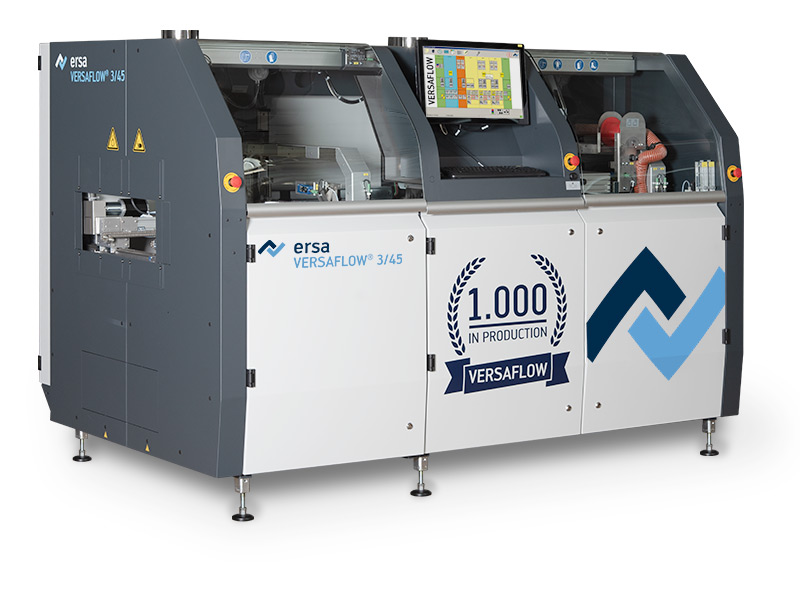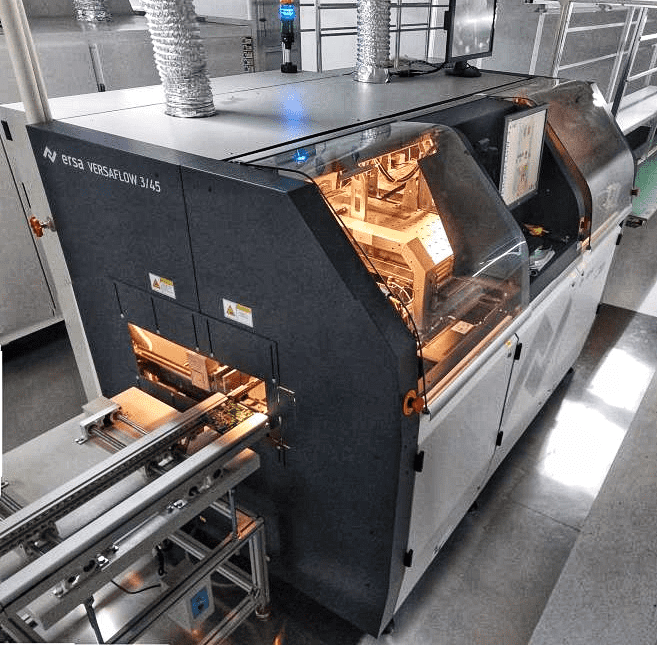Selective soldering launching
In PCBA soldering process, the soldering of plug-in components on the PCBA usually involves manual soldering or traditional automated wave soldering, which entails avoiding surface-mounted SMT materials and certain non-tinned through-holes, requiring the customization of soldering fixtures. This results in additional fixture costs, increased solder consumption due to increased tin surface area, high energy consumption, and significant pollution. Especially in addressing the challenges of producing small batches with a variety of products, the necessary time for fixture fabrication is difficult to meet. In order to better fulfill commitments to efficiency and quality, particularly in meeting the welding needs of high-end products in industries such as automotive, aviation, aerospace, and military, ANKE PCB has recently introduced the most advanced selective wave soldering technology, the German-made ERSA VERSAFLOW 3/45 selective wave soldering machine. This machine thoroughly alleviates and reduces the aforementioned issues, improving the processing efficiency, quality reliability, and stability of soldered products.
Compared to traditional wave soldering, this equipment has the following advanced features:
● Automatic adaptation to PCB
Under the coordination of the MES system, it can automatically call the welding program through QR code recognition on different PCB boards, and achieve fast online switching;
● More reliable quality
ERSA selective wave soldering provides good welding quality – product stability and reliability rate can reach 99.999%. It automatically calls the preset welding program to achieve online adjustment of welding time and solder volume according to the welding requirements of different components. This eliminates device overheating or underheating and ensures no solder bridging or voids, resulting in aesthetically pleasing solder joints.
● Reduce solder consumption
Conventional wave soldering requires a solder inventory of over 400KG, and the solder needs to be continuously melted and agitated, resulting in about 1KG/H of solder dross waste. In contrast, ERSA only requires a solder inventory of 10KG per bath, generating only about 2KG of solder dross in a month. During the soldering process, the soldering iron is protected by 99.999% nitrogen gas, ensuring that 100% of the solder is used on the solder joints and minimizing the generation of solder dross. This feature not only ensures the cleanliness of the soldering surface but also greatly improves the soldering quality and significantly reduces solder consumption.
● More energy-efficient and environmentally friendly
ERSA selective wave soldering is energy-efficient – the power consumption is only 12KW, which is 1/4 of conventional wave soldering. ERSA selective wave soldering eliminates the need for time-consuming and costly specialized fixtures for batch production of conventional wave soldering. The centrally heated solder bath and intermittent automatic preheating reduce energy consumption by approximately 25%. The automated point spraying method for solder joints significantly reduces the use of environmentally unfriendly flux materials by approximately 80% and greatly reduces the pollution from chemical residues generated during the later PCB cleaning process by approximately 70%.
After the introduction and commissioning of the German ERSA selective wave soldering system, the first-pass solder joint quality rate of ANKE PCB’s plug-in components (such as connectors, terminal blocks, etc.) has increased from 91.3% to 99.9%. This has greatly addressed the quality risks and potential hazards in this critical process, providing solid and sufficient guarantee for the soldering reliability and stability of customers’ high-end products. It facilitates the rapid transformation of research and development achievements into marketable goods and also endorses the sustainable development of the products.
Shenzhen ANKE PCB Co.,LTD
2023-8-22

